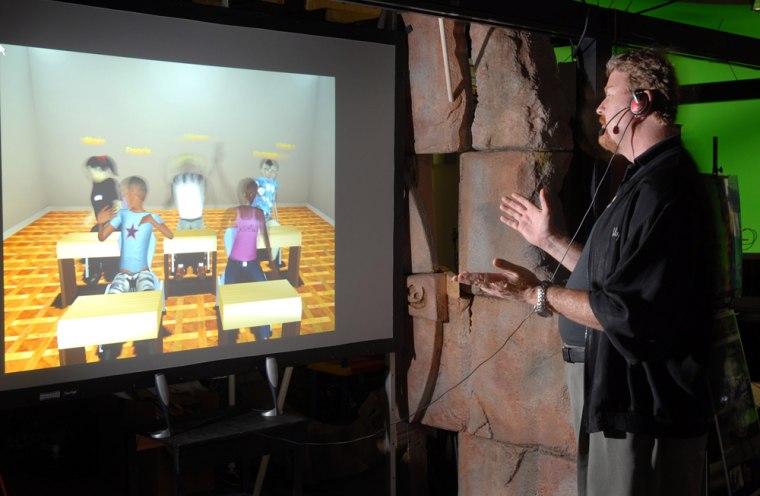A loud boy launches spit balls at a classmate. Another kid slumps in his seat, oozing apathy and his desire to be anywhere else. Other students laugh mockingly and make inappropriate sounds as the rookie teacher faces his worst classroom nightmare.
It's no easy job to regain control and coax the students into writing an essay about what they did last weekend. Fortunately for the teacher, it was only a computer simulation.
The children are a mix of virtual humans projected on a screen and an out-of-sight actress who provides their gestures and dialogue. As the teacher interacts with each kid, the actress assumes the student's identity and movements with the help of technology that senses her motions.
Computer simulations, which have for years been used by the military and airlines, are increasingly finding their way into professions such as teaching, policing, sales and other fields that depend more on interpersonal skills than technical proficiency.
The STAR Classroom Simulator, a partnership between Simiosys LLC, the Haberman Educational Foundation and the University of Central Florida, mixes computer technology and a human role-player. It's currently in trial and is expected to be commercially available within a year.
"I thought it was a great device to see how you would respond in a spontaneous situation with a student that might be either aggressive or have some repressive tendencies," said Kevin Gouvia, a former teacher at an Orlando-area urban high school who recently tried the simulator.
Randall Shumaker, director of the University of Central Florida's Institute for Simulation & Training, said simulators could give realistic but safe training to teachers, whose mistakes can be traumatizing, or suicide prevention counselors, whose errors can be fatal.
"The dropout rate for urban teachers is 40 or 50 percent," Shumaker said. "Part of the reason appears to be they just get thrown into the fires. We can build systems that give people a graded approach so you expose them to this in a virtual world and gradually turn up the heat."
While many lament that people are losing their face-to-face social skills because of cell phones, e-mail and text-messaging, some may receive computer training on how to interact with other humans in the most delicate situations.
SIMmersion LLC, a Columbia, Md., company partially owned by Johns Hopkins University, has developed interrogation simulations for the FBI by filming actors giving different responses, including gestures, to a range of potential questions that an agent might ask.
The footage is then built into a program that responds to a list of questions typed or spoken by the trainee. Unlike the classroom simulator, where responses are controlled by a live actor, the responses are controlled by the computer program itself.
In one, "Rasheed" is a potential informant whom agents must cultivate by demonstrating sensitivity to Arab culture.
Being too abrupt with Rasheed, or telling him that his wife is beautiful, will offend him, and his demeanor will change. Sometimes Rasheed is open, sometimes not, and his motives for talking differ, meaning the same conversation will never occur twice, said Dale Olsen, SIMmersion's president. The system teaches rapport-building with the subject, rewarding a sensitive approach and punishing blunders.
Still, Rasheed is limited — he can't talk about every subject because that technology is several years, maybe decades, away.
All social simulators chase an elusive goal of replicating human behavior.
"We don't quite understand all the things we need to know and we can't quite make the (virtual humans) advanced enough," Shumaker said.
But the advantage comes from providing a safe environment that can be used any time and is a cost-cutting alternative to hiring multiple actors.
"You can't necessarily practice dealing with real people because if you do you will harm people," Olsen said. "People could die or you could get sued."
SIMmersion also has developed a program to help Army chaplains identify and treat soldiers who have suicidal tendencies, and will release a simulation in January that trains people how to counsel a woman who was just raped.
Olsen said he is talking with companies in the communications and pharmaceutical industries to develop tailored programs that train in performance evaluation and sales.
Randall Hill, executive director of the Institute for Creative Technologies at the University of Southern California, created a cultural awareness trainer for the military that combines computer imaging with real props. But he also hopes the technology has a much broader application.
"I want to see these technologies used to transport you to another time and place and be able to interact with people from other cultures," Hill said. "I think we can enhance social skills and cultural knowledge."
